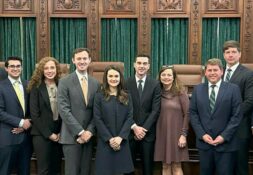Causes and effects of labor shortages across America and at Notre Dame
From reduced hours and darkened fronts of closed eateries to beverage dispensers littered with “Out of Order” labels and snaking lines at the dining hall, the university has clearly been affected by the nationwide labor shortage.
Across the country, there are more jobs available than workers who want them. Job openings were at 10.4 million at the end of September, according to a November 12 report published by the U.S. Bureau of Labor Statistics. That month, the number of quits increased to a high of 4.4 million. Meanwhile, the labor force participation rate remains lower than before the pandemic.
At Notre Dame, Campus Dining and University Catering are the departments most affected by the labor shortage. Senior Director of Campus Dining Luigi Alberganti told the Rover, “Anything related to food and beverage, we feel it. Absolutely.”
Several eating establishments on campus were closed for the semester, including Café Commons in Mendoza, Charron Family Commons in O’Shaughnessy, and Legends. Café de Grasta in Grace Hall followed suit over fall break.
“[Hiring] has been a very, very big challenge. Not only hiring, but retention has been really difficult as well,” Alberganti said. “When we opened the school year, we were about 200 positions understaffed.” There are currently 120 empty positions. “But that doesn’t mean that we hired 80,” Alberganti clarified, “It means we probably hired 150 and lost [about half].”
He added, “It’s really hard to find skilled positions, like the cook position. It’s still very difficult to find anybody who wants to work on the p.m. shift. They still struggle. And that’s why the retail outlets are not open past eight.”
Additionally, supply chain interruptions have affected operations. Menus sometimes change abruptly in the dining hall. “We advertised something, then we need to switch it into something else because we ordered two pallets but received half a pallet,” Alberganti said.
Beyond food services, the decreased labor supply has not affected hiring too much. Director of Talent Acquisition in the Office of Human Resources Matthew Blazejewski partners with various units to manage recruitment for all staff positions on campus.
Blazejewski told the Rover, “We are certainly having no problem. There’s always going to be exceptions, but on the whole we are able to hire people for our roles. In my world, it’s a difference between do I have 100 people applying and interested in those roles and I still have to hire one, or do I have 40 people? That’s the impact.”
Multiple causes contribute to the current decrease in labor supply, many related to the pandemic during which the shortage has arisen.
Professor Joseph Kaboski of the economics department told the Rover, “I think there are two big forces. One is COVID. People are worried about getting COVID. And the second thing is the government responses, [especially in] extending unemployment benefits. And [there are] also other sorts of government income, like child subsidies, that are now going around and the other stimulus-style payments. Out of those two, which dominates, I’m not sure,” he continued.
In an interview with the Rover, labor economist Professor Kirk Doran also identified COVID-19 concerns and stimulus efforts such as moratoriums on evictions and waived student loan payments as reasons for the labor shortage.
He added, “Many people retired during the COVID crisis. And once you make the on-off decision to retire, it’s difficult to come back. Or it’s difficult for the economy to convince you to come back.”
“Finally, there’s an interesting effect in which wages go up for everybody … Given that a lot of people have left the labor force temporarily, or in the medium term, or maybe even permanently, that induces other people to quit [and search for another job], because there’s the possibility of getting a higher salary today,” he said, “So that can set off a lot of people quitting, not because they fundamentally want to not be in the labor force, but because they are trying to respond to the higher wages that have emerged from other people quitting their jobs.”
Similar to Doran’s analysis, Alberganti expressed frustration with being in competition with the manufacturing industry.
“In the area, we have all the manufacturers for the RV industry, for the car industry. They’re paying well—drivers, transportation,” he said. However, Alberganti concluded that “most of the movement was internal,” meaning workers moved around jobs on campus. He cited, “We had a few that decided to go to landscape during the fall.” His estimate for internal turnover is 65 percent, the rest external.
The University’s suspension of hiring from March 2020 to June 2021 contributed to the labor shortage on campus.
“You weren’t allowed to hire for over a year, but people are still leaving,” Blazejewski remarked. “You want to start hiring again. Well, you’ve got to catch up. You’re trying to hire quickly to fill a gap, but you still also have your natural attrition and turnover. And so it magnifies the number of positions you’re trying to fill.”
Alberganti identified the period between commencement last May and the academic year’s start in August as an opportunity for staff “to go and explore,” especially with the absence of summer camps and research programs.
“The kitchens—you work extremely hard. So when people have the time to reflect on their careers, they may have found it attractive to explore other things. Maybe a nine to five job, Monday to Friday, no holidays [working],” he said.
Jane Olsen, a new custodian in Breen-Phillips Hall, worked for Campus Dining until last February. She commented that when COVID-19 struck in March of 2020, food service workers were able to experience other types of jobs on campus, which informed a decision to make a switch.
When students did not return to campus at spring break’s end, Campus Dining workers received three months off. They were also sent to Building Services and Laundry.
“A lot of people go, ‘Wow, this is a pretty neat deal … It’s nice to have Saturdays and Sundays off,’” Olsen said. “And that was for people who have worked 10 to 15 years and always had to work weekends, one or the other day.”
Chris Hatfield, Senior Director of Building Services, confirmed that workers will go back and forth between his division and Campus Dining. “Some of the things that appeal to people that come over to Building Services are the more stable schedule. It’s also a year round [job] so you’re not closing down in the summer like a dining hall is.”
For Olsen herself, who thought her future was in Campus Dining as a cook, the labor shortage has come as a shock. Last year was her twelfth year with Campus Dining and fifth at the Center for Culinary Excellence (CCE). She worked Sunday to Thursday from 6 a.m. to 2:30 p.m.
“On Sunday, I could still do family activities and go see my grandchildren,” she said.
However, in February, she was given two days’ notice of her reassignment at Holy Cross college, where she would work every day except Wednesday and Thursday from 11:30 a.m. to 8:30 or 9 p.m. Her hours and job were entry level, even with her years of experience.
“It was either take this job or you’ll be terminated from the university,” she said. “And I said, no, I’m not going to do this after being here [for 12 years]. I just wasn’t going to get stuck with that. I had spent time on nights because I was new. Everybody kind of has to go through that process. I was unwilling to [do it again].”
As a result, Olsen applied almost immediately for a job with Building Services. Another of her CCE co-workers who was sent to South Dining Hall for only dinner shifts also switched to Building Services. One of Olsen’s current co-workers was formerly a Service Associate in the dining hall for 13 years. Service Associates manage the dining hall food stations. When she was asked to cook in addition to her original duties, she made the switch to Building Services. Olsen told her at the time, “You will be really, really happy.”
Commenting on the nature of work with Building Services, Olsen said with emphasis, “It’s relaxed.”
“I would jokingly say, if I ran my house like they run the dining halls, you know, my bills wouldn’t be paid on time. My kids would probably be taken away from me. I think there’s just maybe too many moving parts and management doesn’t see that,” she said.
Campus Dining and other units around campus have responded to the labor shortage with various creative attempts to boost appeal. “I’m glad that in a university we’re able to be flexible and creative when it comes down to incentives, from incentives to revising the wages to referral bonuses to multiple job fairs. [We increased] the marketing budget for advertising. We’ve delivered some results, but still nonetheless, it’s been a challenge,” Alberganti said.
For Campus Dining and Building Services, since October the minimum wage for both full and part time staff has been $15. Prior to October of last year, the minimum wage for Building Services was $10.76. A cook with experience can make up to $20 an hour now. “The wages went up three times in the last 13 months, for a total of 39 percent for starting wage in Building Services,” Hatfield said.
For those hoping for shorter dining hall lines, patience may be necessary. “I believe that labor markets move slowly. I think given all the forces at work in the labor market right now, it might be another two years before the labor market gets back to normal,” Doran said.
Sarah Hui is a sophomore in the Program of Liberal Studies and Theology. If portals existed, she’d visit Guadalupe, a joyful, lush Costa Rican village, and the folks at Andre House in Phoenix (whilst meeting new friends around the globe). Reach her at shui@nd.edu.






Leave a Reply